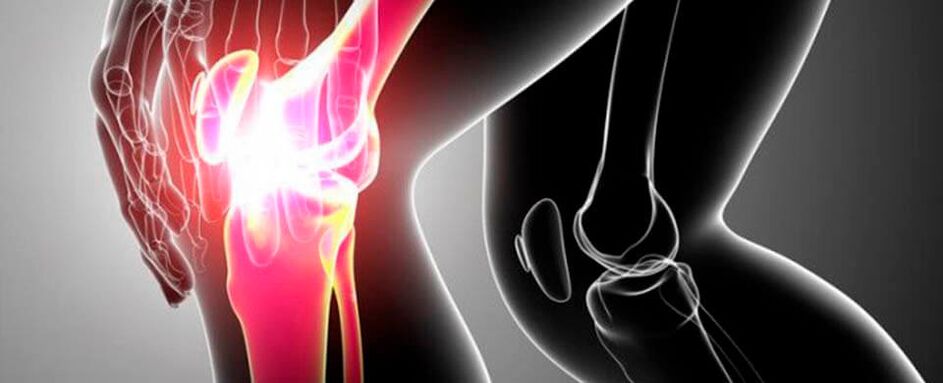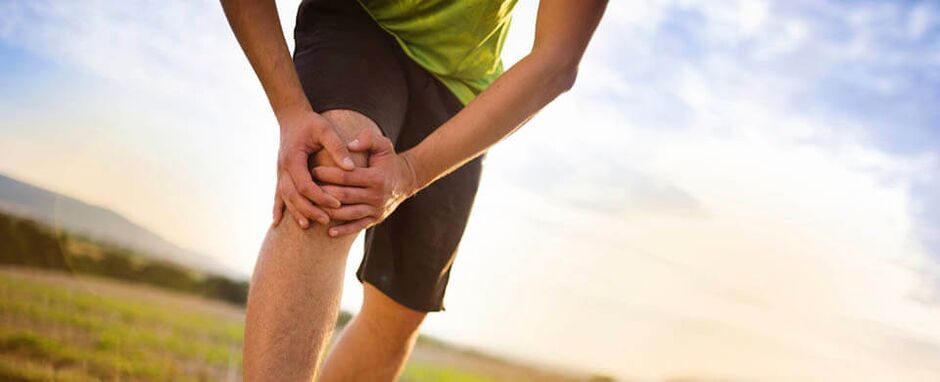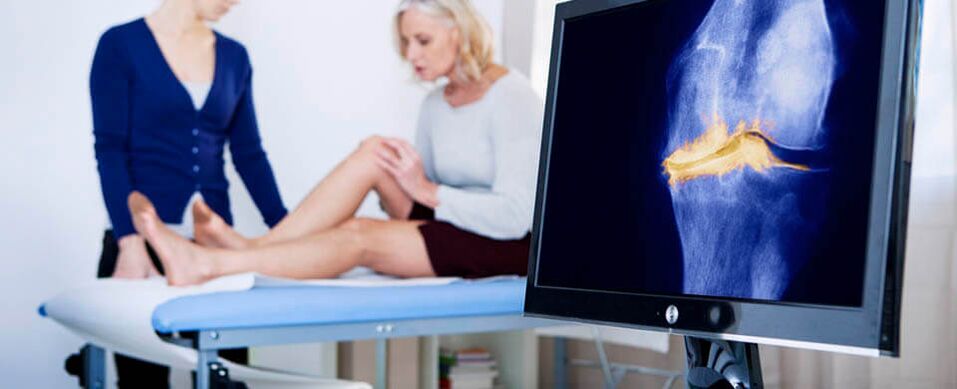
Knee pain is one of the most common symptoms that patients turn to orthopedists and other professionals. Many people completely ignore the appearance of unpleasant feelings, considering them age-related and almost natural. But knee pain has many prerequisites because of its complex structure, influenced by a number of external and internal damaging factors. Some diseases are severe and require urgent treatment.
Who is more likely to have knee injuries?
The knees are made up of several bones connected by muscles, ligaments and tendons. There are also 5 joint bags - cavities surrounded by membranes designed to protect the joint. Between the joints of the bones are interarticular cartilage - the meniscus that helps the knee move freely. Violation of the work of up to part of the knee joint can lead to unpleasant symptoms.
Knee pain is especially common in people with flat feet. It is a pathology of the foot that impairs the shock-absorbing ability of the limbs. As we age, increased strain on the joints causes destruction and inflammation - pain syndrome appears. Different types of deformities of the foot and lower leg have similar consequences.
There are several factors that make knee pain more common:
- overweight;
- Passive lifestyle;
- high sports load;
- Diabetes;
- Vascular diseases;
- Old age;
- Knee surgery and injuries;
- Work with increased load on the legs.

The causes and treatment of knee pain vary greatly, as does the severity of the feelings. If the knee is very sore, it may be due to an injury or an advanced stage of arthrosis, a severe inflammatory process. Sometimes the symptom becomes persistent, even at rest, accompanied by swelling, redness, and cracking. All of these signs should warn a person and force them to see a doctor.
Pain due to bruising of the knee
Among the traumatic causes of joint disorders, bruises are the most common. Why does the knee hurt when the symptoms were preceded only by a minor bruise? Bleeding and swelling of the soft periarticular tissues are accompanied by even minor injuries. As a result, the nerve roots suffer and pain occurs.
In more severe cases, the pain in the knee increases with bending and stretching of the foot, and the person stops moving due to the sharp sensations experienced in the joint. Swelling of the foot is palpable and hot to the touch. How to treat such an injury? Contact a traumatologist, take an x-ray, follow all recommendations, and keep your feet calm.
Often, traumatic hemarthrosis is the cause of knee pain after a banal contusion. This is the outflow of blood into the joint cavity, causing edema and swelling of the joint membranes. As a result, the joint fills with blood and inflammation begins. Without proper treatment, an injury can lead to chronic arthrosis, even at a young age.

Other types of knee injuries
If the foot in the knee hurts and the trauma has contributed to these feelings, the causes lie in various damage to the components of the joint. Here are the main ones:
- Meniscopathy. This is a flattening or tearing of the meniscus. Injury is particularly common in professional athletes, people involved in extreme sports, and household injuries. One feels that the knee is sharply ill, the nature of the feelings is prickly, dagger, the joint loses mobility for a while.
- Tissue damage. Tearing of the ligaments (sprain) occurs when the leg is twisted, after which the limb extends in an unnatural position. There is a sharp pain, the leg swells, the position of the joint changes, it loosens.
- Rupture of the cruciate ligament. Because these ligaments are located inside the joint, injury often leads to the outflow of blood into the knee cavity. Just one stab will help pump out the blood and make an accurate diagnosis.
Aching pain in the knee joint is sometimes accompanied by chronic dislocations of the patella. Without treatment for the acute injury of many patients, the dislocation becomes chronic and causes regular relapse. In children, this pathology causes X-shaped curvature of the foot and leads to severe impairment of its function. Sometimes the pathology affects the knees on both feet.

Inflammatory diseases of the knee
The usual treatment for knee pain is often ineffective. In this case, it is not the joint itself but the surrounding soft tissues that are affected. Thus, tendonitis or tendonitis can be triggered by increased limb strain, leg injuries in the past, allergies, medication reactions, and so on. The knee joint suffers from this disease, usually during the day or in the evening, at night the pain subsides. In the acute stage, the mobility of the joint is severely limited, the syndrome is persistent and cannot be treated with ointments or creams. Sharp sensations are also felt when touching the side of the knee.
If the knee pains regularly, the symptoms worsen after hypothermia, the cause may be synovitis - inflammation of the joint membranes. Inflammatory secretions appear inside the joint, causing cracking and pain. The causes of the pathology are different:
- autoimmune disease;
- Metabolic diseases;
- Injuries in the past;
- Arthrosis.
Another "popular" disease in which the knee hurts is bursitis. It occurs when the bursa (joint sac) becomes inflamed. In addition to the pain syndrome, there is redness, swelling, and increased sensitivity in the patella zone. treating bursitis almost always becomes chronic.

Neoplasms of the knee joint zone
Malignancies of this localization are rare, and pain syndrome is characteristic only at a very late stage. More often, pain in the knee joint is associated with benign formations:
- Baker's cyst. This tumor is located below the knee on the back surface. The appearance of skin above the cyst in a normal, non-inflamed, curved form may cause no swelling at all. In the standing position, a clearly defined, soft, elastic formation appears at the site of the cyst localization. Appears after unilateral knee injury, cartilage damage. Very often the cyst is accompanied by chronic arthritis, arthrosis, rheumatoid arthritis. Large cysts cause not only knee pain but also severe limitation of limb mobility. Additional symptoms due to compression of blood vessels and nerves include cold skin, pallor, goosebumps and numbness.
- Meniscus cyst. It appears in the outer or inner meniscus when there is a cavity with fluid inside the cartilage. The knee in this case hurts after a heavy load or towards the end of the day. Large cysts are seen on the side of the joint, while smaller ones are seen only on ultrasound or x-ray.
A rare pathology is Hoff’s disease - a transformation of the adipose tissue in the joint that becomes fibrous and causes joint dysfunction. This pathology is often caused by arthrosis, which causes pain in the knee joint. Causes - hormonal disorders in menopause in women.

Infectious pathologies of the joint
Against the background of the infection, the knee joint hurts sharply, the rest does not cause relief. Even urogenital and intestinal infections can cause complications in the musculoskeletal system, which can lead to reactive arthritis. Bacteria (salmonella, chlamydia, gonococci, and others) enter the joint cavity of the bones through the bloodstream, colonize the tissues, and cause inflammation. Usually, the tendons are also inflamed, causing the knee to swell and feel hot.
Tuberculosis is a serious disease. Mycobacterium tuberculosis multiplies in the bone tissue, causing bone melting, necrosis of cartilage and soft tissues. Without emergency care, the knee joints are damaged and collapsed, and the process covers an ever-increasing area. As a result, fistulas appear - purulent cavities that can spill and damage the entire body.
Acute, urgent disease of the bone is osteomyelitis. What to do if your knee hurts and the process is accompanied by weakness, muscle aches and fever of up to 40 degrees? If the knee pain is dull, it explodes and the tissues themselves are swollen, red, bluish, an ambulance should be called urgently and emergency surgery should be performed. Otherwise, you may lose your leg or die.

Knee pain - causes of degenerative nature
After the age of 50, a lot of people have knee pain. Prerequisites are aging of the body, wear and tear of the joint devices and the most common pathology - the development of osteoarthritis (gonarthrosis). This leads to thinning, the destruction of cartilage by changing the shape of the bone heads. Most often, in the early stages of the pathology, the knee hurts on one side, and after a few years the lesion becomes bilateral. In the morning, the stiffness of the leg worries, but it wears off quickly. Enhancing the feelings is possible after physical work, intense sports and long walks.
At an advanced stage, the joint tissues collapse and the osteophytes grow to the side of the joint space. These are spikes made of bone tissue that break off in severe cases and cause unbearable pain. There are several degenerative pathologies with symptoms similar to gonarthrosis:
- Osteochondropathy. It affects the joint surface of the bone, it causes trauma and sports. Adolescents can develop for no apparent reason.
- Arthritis. It causes rheumatic, psoriatic, gouty, chronic inflammation and joint destruction.
- Chondromatosis. The etiology is unclear. The disease causes lumps to appear on the joint membranes that restrict knee movement and cause pain.
Menopausal women often have knee pain due to osteoporosis - the bones become thinner, which increases their fragility. The disease is accompanied by leg cramps, spine pain, intermittent fractures.

Other prerequisites for knee pain
When the knee hurts, the etiology of the feelings also lies in the defeat of the peripheral nervous system. Thus, sciatic neuropathy leads to a number of symptoms underlying damage to the lumbar vertebrae. A person has a broken knee, pain around the thighs, weakened limb joints, and disturbed skin sensitivity. The reflexes of the foot also change.
Sometimes the entire knee joint hurts due to vascular disorders. Only in adolescence do you not have to worry much - due to the rapid growth of the body, the vessels do not have time to supply blood to the bones. As you age, the condition of your joint returns to normal - usually by the age of 18-20, the pain goes away completely.
In the case of atherosclerosis in old age, the knee often hurts, so what can be done? Without normalization of fat metabolism, plaque continues to accumulate in the arteries. The blood vessels become clogged, stopping the complete feeding of the joint. Arthrosis develops, the pain becomes chronic. Discomfort in the knee area can also be caused by varicose veins, thrombophlebitis and vascular thrombosis.
How to make a diagnosis?
People's knees hurt quite often - the way to treat the condition can be determined only after the examination. Both sharp and pulling pains in the knee are characteristic of a mass of pathologies, some of which are very dangerous. You should contact a surgeon, orthopedist, neurologist, rheumatologist, traumatologist for a diagnosis. He conducts a survey, finds out the exact symptoms of the disease, determines the accompanying signs. In addition, the doctor will perform a series of tests and physical examinations at the first appointment to clarify the nature of the problem.
What to do if your knee hurts, what instrumental methods help identify the causes? Usually assigned to:
- ultrasound;
- MRI;
- CT;
- Radiography.
The choice of the exact technique should be left to the physician. So ultrasound is a good reflection of the changes in the leg in arthrosis, meniscus damage. Radiography perfectly shows the deformities of the bone, the presence of osteophytes. MRI and CT provide complete information and are essential for complex diseases. In addition, your doctor will order blood tests to rule out inflammation and rheumatism, and a biopsy of the joint will be done if necessary. In case of osteoporosis, densitometry is required - this shows the density of the patient's bone tissue.

Treatment of knee pain
If the pathology is traumatic in nature, traumatologists are involved in treatment, sometimes in a hospital. Mild bruises go away on their own within a few days, so it is advisable to apply absorbable ointments to your knees to allow the hematoma to be absorbed quickly. In case of pain, ointments should be rubbed with non-steroidal anti-inflammatory ingredients.
How to treat if the knee hurts with an inflammatory lesion? In the acute stage of bursitis, arthritis, arthritis, the affected foot needs to rest, and it can be covered with ice for 15 minutes during the first 3 days. Injection of non-steroidal anti-inflammatory drugs and anesthetics directly into the joint relieves severe pain. After pain relief, physiotherapy and practical therapy are prescribed to prevent chronic inflammation of the joint.

If a person has knee pain due to gonarthrosis, what should be done in this case? The main drugs for treatment are chondroprotectors and hyaluronic acid injections. These drugs are designed to restore the nutrition of articular cartilage, resulting in its breakdown. Knee rehabilitation should also include:
- vascular drugs;
- Physiotherapy;
- Gymnastics;
- Massage;
- Vitamin complexes.
Infectious diseases of the joints refer to the introduction of antibiotics into the joint cavities or the oral administration of drugs. In some cases, surgery is needed to remove the tissues affected by the pus. Surgery is also used to treat advanced forms of arthrosis associated with the growth of osteophytes. Sometimes only the replacement of a joint with a prosthesis allows a person to be able to walk normally.



































